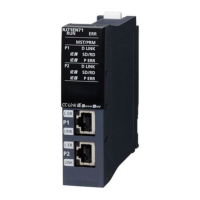78
8 SFC PROGRAM
8.2 Structure
Normal step (without attribute)
A basic step used to configure a block.
While this type of step is active, the transition condition following the step is constantly checked, and when the transition
becomes TRUE, the next step becomes active.
The output status of the action of a step at a transition to the next step varies depending on the instruction used.
■Step without action
A step without an action can also be used as a waiting step.
• While a step is active, the transition is always checked and, when the transition becomes TRUE, the next step becomes
active.
• This type of step works as a normal step if an action is added to it.
Item Description Example
When the OUT
instruction is used
(Other than the
OUT C instruction)
When a transition to the next step occurs and the
relevant step becomes inactive, the output by using the
OUT instruction turns off automatically.
Similarly, the timer also clears the current value and
turns off the contact.
However, the select statement of structured text
language or the output by using the OUT instruction
which is repeatedly using within the statement does
not turn off automatically.
When the transition (2) becomes TRUE while Y0 is turned on by using the
OUT instruction triggered by the action of step (1), Y0 is automatically turned
off.
When the OUT C
instruction is used
If the execution condition of the counter in the action is
already on when the transition becomes TRUE and
activate the step using the counter, the counter is
incremented by 1.
When a transition to the next step occurs before reset
instructions of the counter is executed, the present
value of the counter and the ON state of the contact is
held even if the step using counter becomes inactive.
To reset the counter, use the RST instruction in
another step.
If X10 is already on while step (1) is active, counter C0 counts once when
execution proceeds to step (3) after the transition (2) becomes TRUE.
When the SET,
basic, or application
instruction is used
Even if the active state transitions to the next step and
the step that has used the instruction becomes
inactive, the ON state or the data stored in the device/
label are held.
To turn off the ON device/label or clear the data stored
in the device/label, use the RST instruction in another
step.
When Y0 is turned on by using the SET instruction triggered by the action in
step (1), the ON state will be held even when the transition (3) becomes TRUE
and a transition to step (4) occurs.
When the PLS
instruction or
instructions
executed at the
rising edge is used
Even when the contact of the execution condition is
constantly on, the instruction is executed every time
the step using the instruction changes from inactive to
active.
Even when the contact of the execution condition is on (1), the PLS instruction
is executed every time the step (2) becomes active.

